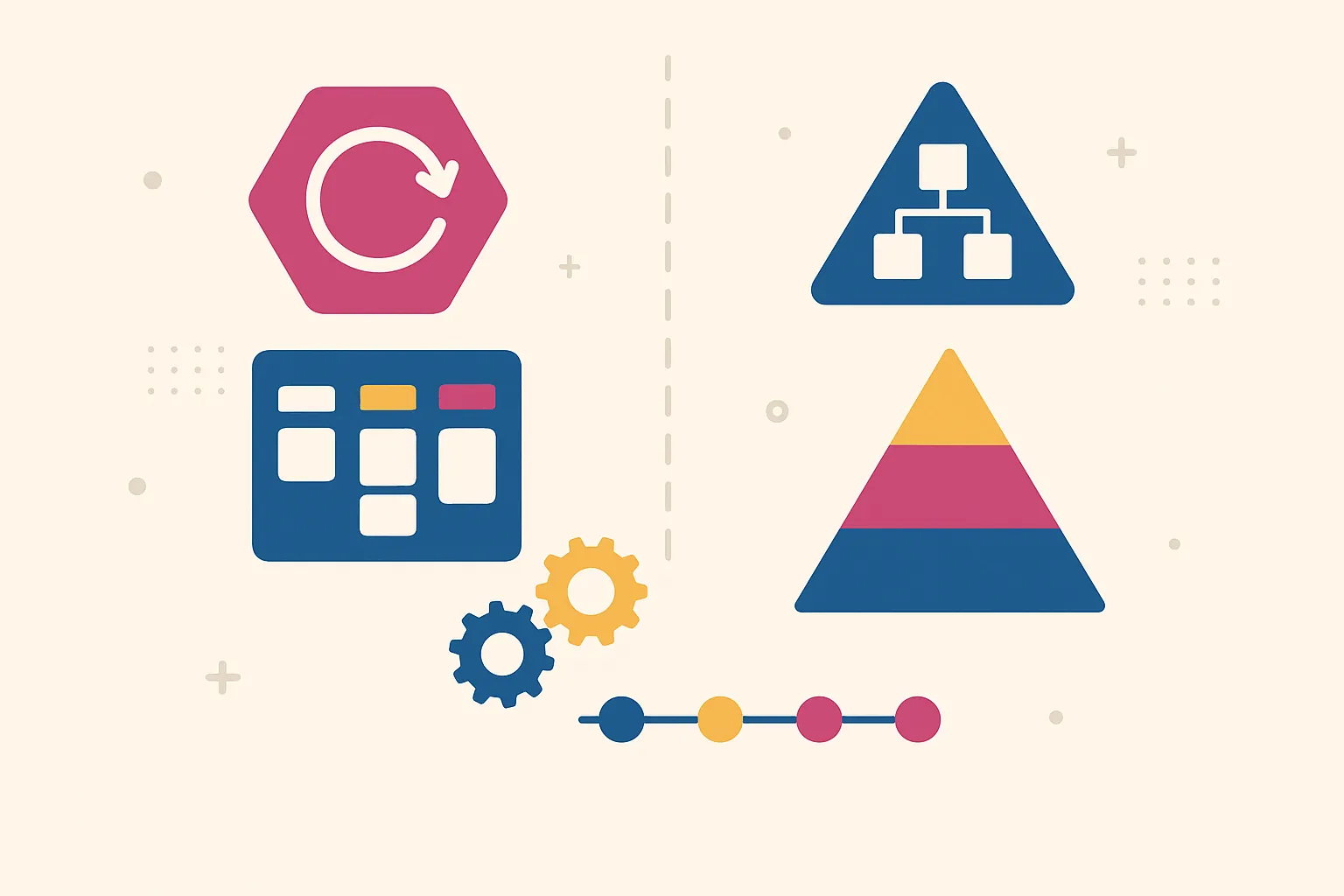Introduction
Portfolio prioritization is a critical process that involves determining which projects should receive resources and attention based on their alignment with strategic objectives. This prioritization is essential as it ensures that organizations focus on the most impactful initiatives, thereby maximizing value and efficiency. By systematically evaluating projects, managers can allocate resources effectively, mitigate risks, and enhance overall project success rates [2][11].
Project management methodologies can significantly influence how portfolio prioritization is approached. Two of the most widely adopted methodologies are Agile and Traditional (Waterfall). Agile management is characterized by its iterative and flexible approach, emphasizing customer satisfaction and the delivery of working software. It allows for adaptability and responsiveness to change, which is particularly beneficial in dynamic environments [1][5]. In contrast, the Waterfall methodology follows a linear and sequential process, where each phase must be completed before moving on to the next. This approach is often seen as more rigid but can be effective in projects with well-defined requirements and low uncertainty [4].
The purpose of this blog post is to provide a comparative analysis of prioritization techniques employed in Agile and Waterfall methodologies. By examining the strengths and weaknesses of each approach, project managers and Scrum Masters can gain insights into how to effectively prioritize their portfolios, ensuring that they align with organizational goals while also accommodating the unique demands of their projects. This exploration will highlight the nuances of each methodology, offering practical guidance for optimizing project prioritization in diverse environments.
Understanding Portfolio Prioritization
Portfolio prioritization is a critical process that involves selecting and managing a collection of projects and programs to maximize organizational value. This concept is particularly relevant in both Agile and traditional methodologies, such as Waterfall, as it helps ensure that resources are allocated effectively to initiatives that align with strategic objectives.
Defining Portfolio in Project Management
A portfolio in project management refers to a collection of projects and programs that are grouped together to facilitate effective management and meet strategic business objectives. This collection can include ongoing projects, proposed initiatives, and completed programs, all of which are evaluated collectively to ensure they contribute to the organization’s overall goals and deliver maximum value [2][14].
The Role of Prioritization in Achieving Strategic Goals
Prioritization plays a pivotal role in project portfolio management by enabling organizations to focus on initiatives that align with their strategic goals. By establishing clear criteria for evaluating projects, organizations can determine which initiatives should be prioritized based on their potential impact, resource requirements, and alignment with strategic objectives [4][6]. This process is essential, especially in environments where resources are limited and strategic demands are high, as it helps organizations navigate competing priorities and make informed decisions about where to invest their efforts [4][14].
Factors Influencing Prioritization Decisions
Several factors influence prioritization decisions in project management, including:
- Strategic Alignment: Projects that align closely with the organization’s strategic goals are often prioritized higher. This ensures that the portfolio contributes to the long-term vision and objectives of the organization [4][6].
- Resource Availability: The availability of resources, including budget, personnel, and technology, can significantly impact prioritization. Projects that require fewer resources or can be executed with existing capabilities may be favored [11][14].
- Risk Assessment: Understanding the risks associated with each project is crucial. Projects with manageable risks or those that offer high rewards relative to their risks may be prioritized over others [4][14].
- Stakeholder Input: Engaging stakeholders in the prioritization process can provide valuable insights and help ensure that the selected projects meet the needs and expectations of those involved [4][14].
Overview of Traditional (Waterfall) Methodology
The Waterfall methodology is a linear and sequential approach to project management that emphasizes a structured progression through distinct phases. This model is characterized by its clear, defined stages, which typically include:
- Requirements Gathering: In this initial phase, all project requirements are collected and documented. This step is crucial as it sets the foundation for the entire project.
- Design: Based on the requirements, the design phase involves creating detailed specifications and architectural plans for the project.
- Implementation: During this phase, the actual development or construction of the project takes place, following the designs laid out in the previous stage.
- Verification: After implementation, the project undergoes testing to ensure it meets the specified requirements and functions as intended.
- Maintenance: The final phase involves ongoing support and updates to the project after its initial deployment.
In the Waterfall methodology, project prioritization is primarily conducted during the upfront planning phase. This involves several key aspects:
- Fixed Scope: Projects are defined with a clear scope from the outset, which means that all requirements must be established before any work begins. This fixed scope allows for a straightforward prioritization process, as all tasks and deliverables are known in advance [3].
- Prioritization Criteria: Projects are prioritized based on strategic objectives, resource availability, and stakeholder input. This often involves evaluating the potential impact and feasibility of each project against the organization’s goals [11].
- Evaluation Model: A structured evaluation model is typically employed to assess and rank projects, ensuring that the most critical initiatives receive the necessary resources and attention [11].
While the Waterfall methodology offers several benefits in terms of prioritization, it also presents challenges:
Benefits:
- Clarity and Structure: The linear nature of Waterfall provides a clear roadmap for project execution, making it easier to prioritize tasks and allocate resources effectively.
- Predictability: With a fixed scope and defined phases, project managers can anticipate timelines and deliverables, which aids in prioritization and planning [4].
Challenges:
- Inflexibility: Once the project scope is set, making changes can be difficult and costly. This rigidity can hinder the ability to adapt to new information or shifting priorities during the project lifecycle [7].
- Delayed Feedback: Since testing occurs after implementation, any issues or necessary changes may not be identified until late in the process, potentially leading to rework and impacting prioritization decisions [4][7].
Overview of Agile Methodology
Agile methodology is a project management approach that emphasizes flexibility, collaboration, and customer satisfaction. It is characterized by iterative development cycles, where projects are broken down into smaller, manageable units called iterations or sprints. This allows teams to adapt to changes quickly and deliver value incrementally. The core principles of Agile are outlined in the Agile Manifesto, which prioritizes:
- Individuals and interactions over processes and tools.
- Working software over comprehensive documentation.
- Customer collaboration over contract negotiation.
- Responding to change over following a plan.
In Agile, prioritization is a critical component that ensures the most valuable features are developed first. This is typically achieved through practices such as backlog refinement and iterative cycles.
How Prioritization Works in Agile
- Backlog Refinement: Agile teams maintain a product backlog, which is a prioritized list of features, enhancements, and bug fixes. During backlog refinement sessions, team members review and adjust the priority of items based on factors such as customer feedback, business value, and technical feasibility. This ongoing process ensures that the backlog remains relevant and aligned with project goals.
- Iterative Cycles: Agile employs iterative cycles, usually lasting two to four weeks, during which teams focus on delivering a set of prioritized features. At the end of each cycle, teams review their progress and gather feedback from stakeholders, which can lead to adjustments in priorities for the next iteration. This iterative approach allows for continuous improvement and responsiveness to changing requirements.
Benefits and Challenges of Prioritization in Agile
Benefits:
- Flexibility: Agile prioritization allows teams to adapt to changing project requirements and customer needs, ensuring that the most important features are delivered first [5].
- Enhanced Collaboration: The prioritization process involves key stakeholders, fostering collaboration and ensuring that everyone is aligned on project goals [8].
- Increased Value Delivery: By focusing on high-priority items, Agile teams can deliver value to customers more quickly, enhancing overall satisfaction [7].
Challenges:
- Subjectivity: Prioritization in Agile can sometimes be subjective, as it relies on team discussions and stakeholder input, which may lead to differing opinions on what constitutes priority [9].
- Overhead: Frequent backlog refinement and prioritization sessions can consume time and resources, potentially detracting from actual development work [15].
- Balancing Short-term and Long-term Goals: Agile teams must navigate the challenge of balancing immediate priorities with long-term strategic objectives, which can complicate decision-making [11].
Comparative Analysis: Prioritization Techniques
Effective portfolio prioritization is crucial for aligning projects with strategic goals and optimizing resource allocation. This section delves into the distinct prioritization techniques employed in Agile and Waterfall methodologies, providing a comparative analysis that will benefit Project Managers and Scrum Masters.
Common Prioritization Techniques
MoSCoW Method:
- Agile: The MoSCoW method categorizes project requirements into four groups: Must have, Should have, Could have, and Won’t have. This technique allows Agile teams to focus on delivering the most critical features first, ensuring that essential functionalities are prioritized to meet customer needs effectively.
- Waterfall: While not as commonly used in Waterfall, the MoSCoW method can still be applied during the requirements gathering phase to clarify priorities before the project moves into the execution phase. However, its iterative nature is less compatible with the linear progression of Waterfall.
Weighted Scoring:
- Agile: Agile teams often use weighted scoring to evaluate features based on various criteria such as business value, risk, and effort. This quantitative approach helps in making informed decisions about which features to prioritize in the backlog.
- Waterfall: In Waterfall, weighted scoring is typically employed during the initial project planning phase. It assists in comparing different projects or features based on predefined criteria, allowing for a structured decision-making process that aligns with the project’s overall objectives.
Cost of Delay:
- Agile: This technique emphasizes the economic impact of delaying a project or feature. Agile teams assess the potential revenue loss or increased costs associated with postponing delivery, which helps prioritize work that delivers the highest value in the shortest time.
- Waterfall: Cost of Delay can also be relevant in Waterfall, particularly when evaluating the financial implications of project timelines. However, the rigid structure of Waterfall may limit the flexibility to adapt to changing priorities based on cost considerations.
Stakeholder Input
- Agile: Stakeholder input is integral to Agile methodologies. Continuous collaboration with stakeholders ensures that their feedback is incorporated throughout the project lifecycle. This iterative engagement allows teams to adjust priorities based on stakeholder needs and market changes, fostering a responsive approach to project management.
- Waterfall: In Waterfall, stakeholder input is typically gathered during the requirements phase. While this initial engagement is crucial, the lack of ongoing interaction can lead to misalignment between stakeholder expectations and project outcomes, especially if requirements evolve over time.
Impact of Project Scope, Time, and Cost
- Agile: Agile prioritization techniques are inherently flexible, allowing teams to adapt to changes in project scope, time, and cost. The iterative nature of Agile means that teams can reassess priorities regularly, ensuring that the most valuable features are delivered first. This adaptability is particularly beneficial in dynamic environments where requirements may shift frequently.
- Waterfall: In contrast, Waterfall prioritization is more rigid due to its linear structure. Changes in project scope, time, or cost can significantly impact the overall project timeline and budget. As a result, prioritization decisions made at the outset are often more challenging to alter, which can lead to difficulties if unforeseen circumstances arise.
Best Practices for Effective Portfolio Prioritization
When comparing Agile and traditional methodologies like Waterfall, portfolio prioritization plays a crucial role in ensuring that projects align with strategic objectives and deliver maximum value. Here are some best practices that project managers and Scrum Masters can implement to enhance their prioritization strategies.
1. Importance of Stakeholder Engagement
Engaging stakeholders is vital for effective portfolio prioritization. Their insights and feedback can significantly influence which projects should take precedence. Here are some actionable steps:
- Regular Communication: Establish consistent channels for communication with stakeholders to gather their input on project priorities. This can include regular meetings, surveys, or feedback sessions.
- Involve Stakeholders in Decision-Making: Encourage stakeholders to participate in the prioritization process. This not only helps in understanding their needs but also fosters a sense of ownership and commitment to the projects selected.
- Utilize Stakeholder Mapping: Identify key stakeholders and their influence on various projects. This can help in prioritizing projects that align with their interests and organizational goals, ensuring that the most critical projects receive the necessary attention and resources [1].
2. Flexibility and Adaptability in Prioritization Strategies
Both Agile and traditional methodologies require a degree of flexibility in prioritization to respond to changing circumstances. Here are some tips to enhance adaptability:
- Iterative Review Process: Implement a regular review cycle for project priorities. In Agile, this can be done through sprint retrospectives, while in Waterfall, it can be integrated into phase reviews. This allows for adjustments based on new information or changing business needs.
- Embrace Change: Foster a culture that welcomes change. Encourage teams to be open to re-evaluating priorities as new projects emerge or as market conditions shift. This is particularly important in Agile environments where change is expected and can lead to better outcomes [2].
- Use Data-Driven Decision Making: Leverage analytics and performance metrics to inform prioritization decisions. This can help in identifying which projects are delivering the most value and which may need to be deprioritized [3].
3. Balancing Short-Term Needs with Long-Term Goals
Finding the right balance between immediate project demands and overarching strategic objectives is essential for successful portfolio management. Here are some strategies to achieve this balance:
- Define Clear Strategic Objectives: Establish clear, measurable goals that align with both short-term and long-term organizational strategies. This will serve as a guiding framework for prioritization decisions [4].
- Prioritize Based on Value and Impact: Assess projects not only on their immediate benefits but also on their potential long-term impact. This can involve evaluating how each project contributes to strategic goals and overall business growth.
- Create a Portfolio Roadmap: Develop a visual roadmap that outlines project timelines, dependencies, and strategic alignment. This can help in making informed decisions about which projects to prioritize based on their alignment with both short-term and long-term objectives [5].
By implementing these best practices, project managers and Scrum Masters can enhance their portfolio prioritization processes, ensuring that they effectively balance stakeholder needs, adapt to changes, and align projects with strategic goals. This approach not only maximizes value delivery but also fosters a more agile and responsive project management environment.
Conclusion
The approach to portfolio prioritization can significantly influence the success of projects. This comparative analysis of Agile and Waterfall methodologies highlights several key differences in their prioritization techniques:
- Flexibility vs. Structure: Agile prioritization is inherently flexible, allowing teams to adapt to changing requirements and customer feedback throughout the project lifecycle. In contrast, Waterfall prioritization follows a more structured approach, where project phases are defined upfront, and prioritization is based on initial project goals and timelines [1][4].
- Customer-Centric Focus: Agile methodologies prioritize customer satisfaction by continuously delivering value and incorporating stakeholder feedback. This contrasts with the Waterfall approach, which often emphasizes adherence to the original project plan and scope, potentially leading to less responsiveness to customer needs [5][7].
- Iterative Evaluation: Agile prioritization involves regular reassessment of project priorities during iterative cycles, enabling teams to pivot as necessary. Waterfall prioritization, however, typically involves a one-time evaluation at the project’s outset, which can limit adaptability as the project progresses [1][8].
As project managers and Scrum Masters reflect on their own prioritization approaches, it is essential to consider how these methodologies align with their project goals and team dynamics. Assessing whether a more flexible Agile approach or a structured Waterfall method suits their projects can lead to improved outcomes and enhanced team performance.
To deepen your understanding of portfolio prioritization, consider exploring the following resources:
- Books and Articles: Look for literature that delves into Agile and Waterfall methodologies, focusing on case studies and practical applications of prioritization techniques.
- Webinars and Workshops: Participate in training sessions that offer insights into effective prioritization strategies and tools tailored for both Agile and Waterfall environments.
- Professional Communities: Engage with forums and groups dedicated to project management, where you can share experiences and learn from peers about best practices in prioritization.
By continuing to explore and refine prioritization techniques, project managers and Scrum Masters can enhance their effectiveness in delivering successful projects that meet both organizational objectives and customer expectations.
Find out more about Shaun Stoltz https://www.shaunstoltz.com/about/.
This post was written by an AI and reviewed/edited by a human.



